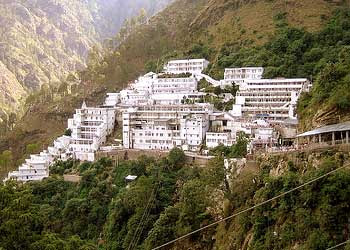>
Jai Mata Di. With those words in the darkness before dawn, we began a pilgrimage to Vaishno Devi in northern India to worship the Hindu goddess Mata Rani. My extended family and I were journeying from Mumbai to the state of Jammu and Kashmir by train, which was to take thirty hours. We approached Bandra station in Mumbai as the first signs of day peaked over the horizon. I knew we were close when greeted by the station’s infamous calling card, the rank smell of sewage.
While planning this trip, there had been great debate among my relatives about two pressing matters: first, the food each participating family would bring along (because once we got sick of the company, we could eat and get sick to our stomachs), and secondly, whether to book the 2 Tier first class cabin or the 3 Tier. As far as the latter was concerned, the only apparent difference was that a 2 Tier cabin consisted of two sleeping bunks per wall versus three bunks in a 3 Tier. We had opted for two bunks per wall, and when the day of the trip finally arrived, everyone was eager to jump into the much exalted 2 Tier train car. Having seen The Darjeeling Limited and Slumdog Millionaire over the past year, I might have prematurely romanticized my expectations for Indian train travel. My heart sank the second I climbed into our box. While I could potentially forgive the rust encrusted walls and muddy bathrooms, the fact that the “tinted” windows (which in reality were poorly maintained windows stained by dirt) precluded any sightseeing of the Indian countryside was a bit much to handle.
Nevertheless, thirty-four and a half hours, eight meals, one sleepless night, and five too many bathroom visits later we reached Jammu.
Our ascent up the mountain upon which Vaishno Devi rests began from a small village called Katra. We stayed in the village the previous night, and were it not for the damp sheets at the hotel, which the staff insisted were not wet but rather only cold, the visit might have earned a Trip Advisor four star review. We started our thirteen kilometer uphill trek slowly. Having overeaten throughout the train ride, the walk and exercise was refreshing. It also provided a rare occasion to praise India’s infrastructure. The pathway up the mountain was narrow but for the most part felt safe. Certain devotees opted to take horses and donkeys up and down the mountain, and when those animals thundered up and down the path, we did have to avoid getting bumped over the edge. Still, I felt grateful for the pathway when I noticed the remnants of the original perilous stone steps pilgrims used to climb.
As a Hindu, it did not surprise me to see just how dedicated worshipers were to make it to the top. To outsiders Hindu zeal might at times seem borderline superstitious. Even that day one of my cousins, always ahead of the pack, was making the entire climb barefoot to fulfill a promise he had made to the goddess. To my right I saw a six-year-old boy on his father’s shoulders leading a religious chant even as they descended after their pilgrimage was complete. Just behind me another of my older cousins was out of breath, but he panted “Jai Mata Di” incessantly to strengthen his resolve. He was careful not to offend the goddess on this trip. During his previous visit he was very vocal about his discontent when he realized that after climbing thirteen kilometers for Mata Rani, her cave only housed three symbolic stones. Shortly thereafter, he fell gravely ill just a few yards into the return descent. Already teetering on the edge of sickness throughout my stay in India, I donned a sunny disposition.
About five hours later we hit kilometer checkpoint eleven at an hour in which the sun’s disappearing light blurred the outlines of nearby objects in contrast with the sharp mountain peaks in the distance. We rounded a bend and started up an unusually steep fifty yard stretch. Striding up the gravel path, my line of sight cleared the top of the small hill, and I received my first glimpse of the cave and the mini village that now housed Mata Rani’s presence. It was a good moment. I thought about how often we forget good moments, but I promised myself to remember this one. A sense of serenity washed over me, and I felt more alive than I had in weeks.
The rest of our visit was relatively uneventful but chock full of monkeys stealing our food, security officers taking my cousin’s inhalers but not finding mine, unheated hotel rooms, and my cousin’s husband’s toe getting nicked by a horse’s hoof. The travel back to Mumbai, on the other hand, proved to be quite harrowing.
With a collective feeling that perhaps the grimy train compartment, freezing hotel rooms, and lingering stomachaches and colds were worth the successful pilgrimage after all, we waited for our flight from Jammu to Mumbai. Mata Rani, however, decided to test our faith for just a while longer. Fog at the connecting airport in New Delhi had delayed all the flights heading south from Jammu, except for one airline. This airline, our airline, instead decided that it would cancel all its flights and refund tickets. We would later find out that the cancellation was likely caused by staffing problems, but because the inclement conditions served as a credible scapegoat, the airline did not help us find a way home. All other flights and trains were booked for the next two days, and given that only one week remained in our visit to India, staying in Jammu was not an appealing option. Thus, we embarked yet again on another Indian travel experience that will forever be burned to memory. Jai Mata Di.
*****
My uncle hired a driver, and the nine of us from the original nineteen who were left stranded packed into a rickety van. To travel the 600 kilometers from Jammu to New Delhi we settled in for what we figured would be an eight to ten hour ride. Agitated with the circumstances, my brother and a few others dozed off immediately, and the rest of us tried to make light of the situation. Any hope for levity, however, was dashed an hour into the return trip when the driver decided to take a chai break. We sipped and snacked away for about fifteen minutes until realizing we had no clue where the driver had disappeared. A couple of the men from the group went on a search and returned with the driver several minutes later, poorly hiding their consternation. My eavesdropping nine-year-old cousin ran back to inform us that the dispatcher/middleman who arranged our taxi had in fact taken a much larger cut out of the driver’s fare than customary.
The driver reluctantly sat back at the wheel once we reassured him we would not stiff him on the remainder of his fare. My uncle also suggested that he could call the middleman in Jammu to ask for a partial refund and return it to the driver. Seemingly appeased, the driver started the engine, but before continuing forward he suggested that my uncle accuse the dispatcher of wrongfully pocketing even more money than he actually had. This way, the driver reasoned, he could collect an even higher fare and could also cut my uncle in for a few rupees.

In many ways, the driver’s retaliatory scheme exemplified the dark underbelly of Indian society’s mindset. Corruption is only met with more corruption. Even on the train ride to Jammu, the TC (train conductor) tried to entice us to enter into a shady transaction. We had paid for nineteen bunks, but the nineteenth person in our party was not to join us until three-fourths of the way into the trip. The TC insisted on letting standby passengers occupy the bunk so that he could make a few extra rupees in bribes from those passengers. We would have been glad to let those people take the seat for free until our 19th boarded, but the problem with the cycle of corruption is that we later would have had to bribe those passengers and/or the TC to get the bunk back. My twenty-three year old cousin, endearingly nicknamed Shanky, once summed up the general Indian state of mind when he rationalized, “If I saw a goat (an innocent mark or victim) on the street, wouldn’t I obviously take him for as much as I could get?” People in India are generally great, but when it comes to money, they often exhibit hyper capitalistic tendencies.
The next few hours of the drive until nightfall passed more smoothly but very slowly. While Punjab’s interstate roads exceeded my expectations, they were not the five lane interstate highways I was used to cruising at home. To add just a tinge of peril, as dusk enveloped the country side, so did the region’s notorious fog. The two lane highway was soon cutting through dense forests, and the fog settled in densely between the trees lining either side of the road. The driver had already slowed down to thirty-five kilometers per hour when the road turned into a one lane path with a serious traffic jam.
Having only covered 150 kilometers, we were already five hours into the trip and found ourselves in the middle of a jungle. When Indian infrastructure receives criticism, it is because of these nightmare scenarios. Our flight from New Delhi to Bombay was scheduled for 7:30 AM the next day, and with three-fourths of the journey left, it was already 9:00 PM. We had trouble making up time even on decent highways because of the fog. While fog was admittedly out of government control, this natural hazard was a recurring problem on a route frequently used by freight truckers, and the government could have deployed roadside reflectors and streetlights to help ameliorate the issue.
My cousin’s husband decided to scout out the source of the traffic jam to no avail. He just shrugged and decided such things were to be expected in India. We were at a standstill for a half hour. Initially, we had joked about ghosts or bandits jumping out of the bush to our right, but the van gradually grew quiet as those stories took hold of the deeper recesses of our thoughts. This patch of road wasn’t a particularly safe area. Two men on motorcycles interrupted the silence then as they tapped on the driver’s window.
They encouraged the driver to take the narrow dirt trail to the left as a detour. Without the possession of GPS or local familiarity we kindly declined. The motorcyclists seemed very disappointed that we balked at their suggestion and zoomed away on their bikes down the path. I tried to follow their fading silhouettes with my eyes until another knock at the driver’s window distracted me. This time it was the truck driver stuck in traffic behind us. He also tried to convince us of the merits of this side trail. When our driver replied with a Punjabi idiom that he didn’t want to take any ‘raw’ roads, the trucker argued that the road was ‘fully cooked.’
We continued to wait with quickly sinking stomachs. After a few minutes, a couple of cars ahead of us turned their engines back on and veered off onto the much hyped detour path. Before taking our van forward, the driver turned to my uncle. My uncle confidently directed the driver to follow the cars down the side path because we had to make up time if we planned to catch our flight.
As our van set off down the dirt path, I kept a watchful eye out the back window to see if the trucker who had advocated this suspicious road was following. At first I was relieved to discover that he was staying put, but then it occurred to me that he might have been in cahoots with the first two motorcyclists who had since disappeared. After all, we were probably an easy target with luggage nearly toppling over the sides of the van roof. I found myself slightly less unnerved when we caught up to the two cars that had led the way down the sketchy path. Both cars cleared over the railroad crossing directly ahead of us. As our van approached the tracks, however, the warning bell rang, and the wooden barrier wedged itself between the tracks and us.
The temptation to run through the light and siren to the other side of the tracks was high. We could not make out if there was anyone manning the booth on the other side, from which government transportation employees manually control the railroad track barrier. Yet, it seemed too risky even to wager the few seconds it would take to cross the tracks. India’s railway system is probably one of the deadliest in the world. Accidents due to compartment overcrowding and poor traffic signaling were absurdly common. Knowing that 17 people die per weekday on the suburban trains of Mumbai, one could only guess the dangerous unpredictability of these regional trains.1 Within a few minutes, our window to cross over the tracks closed as a singular train light glimmered in the distance.
As I turned my eyes to the rear of the van, I saw two pale headlights steadily approaching. They ran parallel at a fixed distance before suddenly splitting further apart and then weaving again to be completely adjacent. Although the source of the lights was not easily distinguishable, it was clear that they belonged to a pair of two-wheeled vehicles. Our collective anxiety was palpable as we tried ignoring the two tailing lights and listened to the rhythmic clanking of the train against the rusted tracks. In a few moments the train finally cleared our path, and the wooden barrier creaked open. Without looking back, the driver jolted forward. The detour proved to be efficient, and we returned to the main highway in just a few minutes. As heart rates settled and breaths were caught, my ostensibly confident uncle admitted that he had been discreetly searching for some sort of weapon and had clutched two screwdrivers at his feet.
Whether actual or conjured in our minds, the preceding drama took its toll, and most of us started dozing in and out. I, too, closed my eyes and was awakened a couple of hours later by my gurgling stomach. As I came to consciousness, a neon light shone through the dense fog. We were still in the middle of a jungle as far as I could tell and had not come across any presentable rest stops or restaurants in hours. No wonder I couldn’t help but smile when the familiar beacon finally became visible ahead. Along the most isolated of roads stood a comforting sight: the golden arch of McDonald’s. With no hesitation we had the driver stop as we indulged in the luxuries of clean bathrooms and processed food.
*****
We did eventually make our flight out of New Delhi, but as we had expected by then, the travel was laden with inconveniences. The fog did not let up throughout the night. Hours behind pace, the inexperienced driver would not push the car past 60 kilometers per hour, prompting my uncle to ask for the wheel. When the driver refused, my uncle mushed him along for the remaining duration. Once in Delhi, the driver refused to stop for a couple of policemen randomly searching cars near the airport. Instead, he accelerated right over one officer’s foot. We gasped as he floored it toward the airport. I was baffled when the police did not give chase. The police in India are easily bribed, and people can almost always avoid tickets. Not to pursue someone who drives over an officer’s foot, however, seemed too apathetic even for India. Finally, we made our flight but only because it was delayed by an hour due to fog. As we boarded the plane, I exhaled, “Jai Mata Di.”
Continue to Part 3
1 Blakeley, Rhys. “India’s Rail Authorities Crack Down on Rooftop Travel to Stop Deaths.”
Times Online, Feb 18, 2010.















